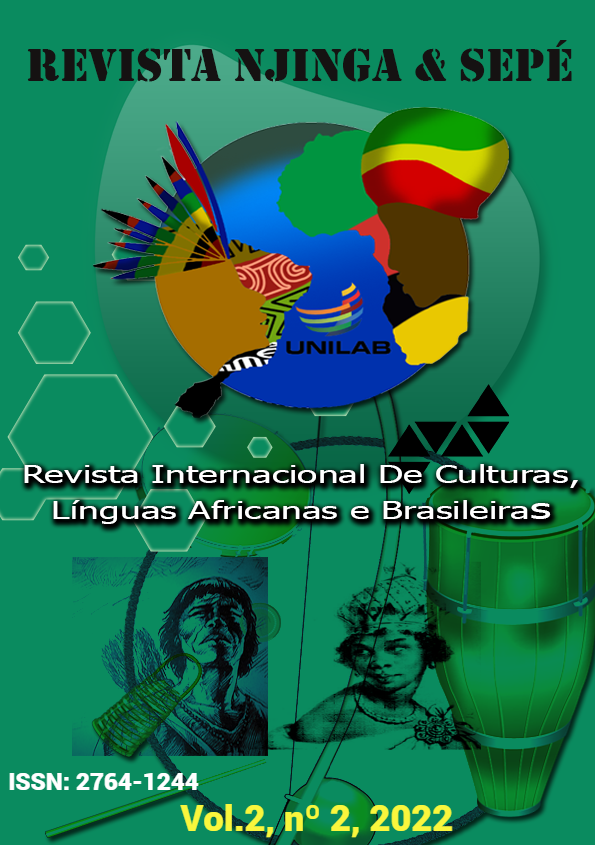3.Extensões que incrementam a valência de verbos meteorológicos
Mots-clés :
Extensão, Valência, Verbos Meteorológicos, ArgumentoRésumé
O artigo tem por objectivo geral explicar a natureza do argumento adicionado ao verbo meteorológico pela concatenação de algumas extensões verbais. Metodologicamente é uma abordagem qualitativa, guiada pelo quadro teórico gerativo, no Programa Minimalista (PM) e, mais particularmente, de Chomsky (1995). Os dados analisados foram coletados em distrito de Pemba, Moçambique, na comunidade fala da língua mwani mediante um questinário impresso. Portanto, são dados de produção de percepção da escrita. O presente artigo pretendia responder a pergunta segundo a qual: qual é natureza dos argumentos adicionados pelos afixos em Kimwani? A análise dos dados mostra que cada extensão projeta seu próprio núcleo funcional em que a extensão é alojada e projeta seu próprio especificador, em que os argumentos inseridos recebem de forma configuracional os papéis temáticos. A extensão causativa e aplicativa adicionam mais um argumento hierarquicamente diferente na construção.
***
Mwacigwatho: Basali la kucemeredwa “Construções Ideofónicas do Léxico Nyungwe” nkhuyambiratu kucitiwa ncinyungwe. Martins (1991), mu livu lace Elementos da Língua Nyungwe – Gramática e Dicionário Nyungwe-Português-Nyungwe, adayikha lonkho lonkho maideofone za cinyungwe, tsono alibe kuzithumbudzula. Nhampoca (2018, 22016, 2015, 2010, 2009) ana mabasa yawo ya maideofone, tsono nga cichangani. Mphicha ibodzi ya kunesa ya mapfundzoya yomwe ikanati kupfuduliwa nkudziwa kuzindikira ideofone na onomatopeia, napo iciwoneka ninga ndjakupusa, kazindji kentse ni basalini la kupusa, napombo pacikhala na malivu ya manembedwe yabzwo. Mphicha inango nkusayika kwa malivu ya bzwimwebzwi ya cinyungwe. Ninga mayezezo, na kutetekera cirewedwe na kufufudza bwino Martins (1991), ndzeru ziwiri zidacoka padeca: i) mazindji mafala yangakondzedwe na maideofone na ii) maideofone, ndikati so, yangakondze fala liri rentse. Na tenepa, bzwikulu bzwomwe bzwikhatsungiridwa mpswibzwi: 1) kunyang’ana nyang’ana mphambvu za maideofone za kukondza mafala ya cinyungwe na 2) kuthandiza kunemba bzwa maideofone za cinyungwe. Macitidwe yace bzwimwebzwi ndja kutoma kuwonesesa bwino kuti cirewedweci cidasemewa tani na kuthumizira na umisiri na umbadwe bwangu ncinyungwe. Ndipo bzwidadzawoneka kuti maideofone yadakhala ninga makhuli komwe yambamera mafala mazindji ya cinyungwe. Nakudziwa kuti basa lipswa ninga yiri kuphonya kungasayikerini – nyakusaya kucita basa ndiye amphonyalini – tinkhulupirira kuti kutsogolo kuno basali lin’dzafamba mwakulungama, licidzayenderera na kukondza bzwinango kuti yawande manembedwe ya cinyungwe.
Téléchargements
Références
BECK, David. Ideophones, adverbs and predicate modifiers in Upper Necaxa Totonac. Departament of Linguistics, University of Alberta, 2005.
BIRIATE, Mário. Avanços no estudo de Ideofones. (Blog desenvolvido por Mário Biriate), 2014. Disponível em: <http://uptete.blogspot.com.br/>. Acesso em: 21 ago. 2015.
DINGMANSE, Mark. The meaning and use of ideophones in Siwu. Radboud University Nijmegen, 2011.
FELIX, Ameka; MARK, Dingemanse. Ideophones, interjections and particles: their forms and uses in Dompo Ester Manu-Barfo Ideophones, Linguistics, Oxford Bibliographies (02.08.12)
KIMENYI, Alexandre. Iconicity of ideophones in Kinyarwanda: form, function, content and context. Califórnia State University at Sacramento, Califórnia, [s.d]. Disponível em: <http://kimenyi.com/iconicity-ofideophones-in-kinyarwanda.php>. Acesso em: 26 mai. 2015.
KULEMEKA, Andrew Tilimbe Clement. Sound Symbolic and Grammatical Frameworks: a typology of ideophones in Asian and African languages. South African Journal of African Languages, vol. 15, nº 2, p. 73-84, mai 1995.
LANGA, David. Ideofones em changana. In: NGUNGA, Armindo; PEREIRA, Inocêncio (Org.). Progressos da Investigação em Ciências Sociais e Humanas. Maputo: Imprensa Universitária, Universidade Eduardo Mondlane, 2004. p. 59-77.
LANGA, David; NHAMPOCA, Ezra Chambal. Análise fonológica e semântico-cognitiva dos ideofones do changana. Linguagem: Estudos e Pesquisas, Goiânia, vol. 22, nº2, 2019.
MARTINS, Manuel dos Anjos. Elementos da Língua Nyungwe: gramática e dicionário Nyungwe-Português-Nyungwe. Lisboa: Editoral Além, 1991.
MOURA, Heronildes; NHAMPOCA, Ezra. Um caso de iconicidade em classes de palavras: os ideofones na língua changana. Signo, Santa Cruz do Sul, vol. 42, nº 75, p. 48-58, set./dez. 2017.
NHAMPOCA, Ezra. Identidade categorial e função dos ideofones do Changana. 2018. 347 f. Tese (Doutorado em Linguística) – Universidade Federal de Santa Catarina, Centro de Comunicação e Expressão, Brasil, Florianópolis.
NHAMPOCA, Ezra. Compilação de um dicionário de ideofones do changana: uma proposta metodológica. Saarbrucken: Novas Edições Acadêmicas, 2016.
NHAMPOCA, Ezra. Um Estudo Preliminar sobre alguns aspectos da morfologia dos ideofones do changana. Linguasagem, São Carlos, vol. 24, nº1, 2015.
NHAMPOCA, Ezra. Uma proposta metodológica para a compilação de um dicionário de ideofones do changana. 2010. 67 f. Dissertação (Mestrado em Linguística) – Faculdade de Letras e Ciências Sociais, Universidade Eduardo Mondlane, Maputo, 2010.
NHAMPOCA, Ezra. Revisitando alguns ideofones do changana. In: NGUNGA, Armindo (Org.). Lexicografia e descrição das línguas bantu. Maputo: Centro de Estudos Africanos, Universidade Eduardo Mondlane, 2009. p. 137-146.
Rego, Sóstenes Valente. Papel e lugar de ideofones/ onomatopeias na língua Nyungwe. Centro de Línguas, UP, Maputo, Aula Aberta: https://meet.google.com/nhx-quey-wrc (22.06.2022).
Sitografia
https://ciberduvidas.iscte-iul.pt/consultorio/perguntas/familia-de-palavras-de-aviao/36705 [consultado em 05-08-2022].
Quantos são os alfabetos do mundo? (certaspalavras.pt)
https://observador.pt/.../pior-e-impossivel-portugal-e-a.../escravatura
Téléchargements
Publiée
Comment citer
Numéro
Rubrique
Licence
(c) Tous droits réservés NJINGA&SEPÉ: Revista Internacional de Culturas, Línguas Africanas e Brasileiras 2022

Ce travail est disponible sous licence Creative Commons Attribution - Pas d'Utilisation Commerciale - Pas de Modification 4.0 International.
Les auteurs qui publient dans cette revue acceptent les conditions suivantes:
Les auteurs conservent le droit d'auteur et accordent à la revue le droit de première publication, l'œuvre étant simultanément concédée sous licence Creative Commons Attribution License, qui permet le partage de l'œuvre avec reconnaissance de la paternité de l'œuvre et publication initiale dans ce magazine.
Les auteurs sont autorisés à assumer séparément des contrats supplémentaires, pour la distribution non exclusive de la version de l'ouvrage publié dans cette revue (par exemple, publication dans un référentiel institutionnel ou en tant que chapitre de livre), avec reconnaissance de la paternité et publication initiale dans cette revue.
Les auteurs sont autorisés et encouragés à publier et distribuer leurs travaux en ligne (par exemple dans des référentiels institutionnels ou sur leur page personnelle) à tout moment avant ou pendant le processus éditorial, car cela peut générer des changements productifs, ainsi que citation des travaux publiés (voir l'effet du libre accès).




